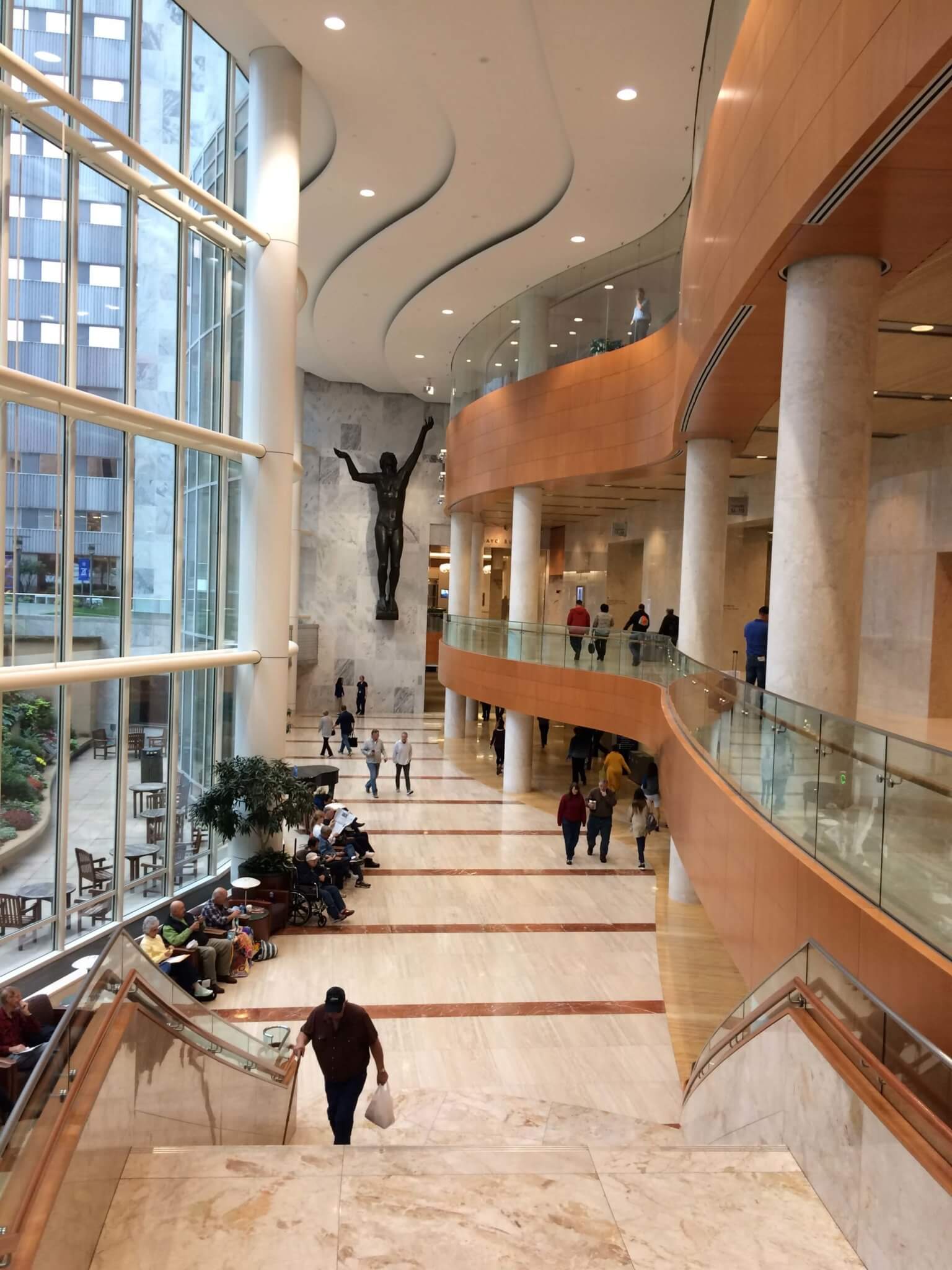Stefan K. G. Grebe
Rochester, Minnesota, United States
Mama, take this badge off of me / I can’t use it anymore. / It’s gettin’ dark, too dark to see / I feel I’m knockin’ on heaven’s door
“Knockin’ on Heaven’s Door,” Bob Dylan
 |
|
The main foyer of the Gonda building, Mayo Clinic |
If the injured deputy in Bob Dylan’s lyrics had been living in today’s United States, he would have been whisked to the hospital and conceivably snatched from the jaws of death. Yet depending on his type of health insurance, he might have retrospectively wished his knocking on heaven’s door had been answered and that he had been ushered into paradise rather than into a trauma center. The cost of the treatment for his gunshot wound to the chest could well have exceeded his insurance cap, leaving him alive but bankrupt, with a debt that his children might still be paying off after he had died of old age.
How is this possible? How did we get to this point? Much of the last decade in the United States has been dominated by discussions on health care reform, but the root cause of what ails most developed countries is actually that healthcare has evolved into a new, universal, planet-spanning pan-religion.
The medical pan-religion is arguably more powerful than conventional religions, because it delivers more consistently on its promises—a life saved, a heart mended (literally or figuratively), pain relieved. Modern medicine uses the tools of conventional religions, such as the promise of salvation if the faithful follow the words of the scripture: if you eat your greens and follow the various stations of preventive medicine you will be saved; ignore the mantra and eat red meat or miss your mammogram and you will be damned. Deliverance comes if you pray at the altars of Hippocrates, confessing your sins to your primary care physician or, in more dire cases, to the specialist at a medical center cathedral of this new religion.
Among these institutions, my own medical facility arguably represents the equivalent of St. Peter’s Cathedral. A monumental Jesus-like statue hangs on the wall of the main building’s grand lobby. With its majestic sky-high ceilings, multi-story tall windows, Italian marble and huge pillars, it is a cathedral in all but name.
On the ground below, the faithful are crisscrossing, hurrying from appointment to appointment. Priests and their junior disciples wear a conservative business suit and a name badge. Larger numbers of non-ordained support staff, in the customary garments of their assigned functions, wind their way through the sea of believers.
The attire worn in our institution is more ornate than that worn by priests and acolytes in other churches of medicine, who favor a white robe with large side pockets adorned with medico-religious tools and symbols. The number of these reflex hammers and stethoscopes, ball-point pens and pagers, is generally inversely proportional to rank. Interns often carry two or more pagers; fully ordained consultants usually no more than one. The patients are usually more plainly dressed, the modern equivalent of the rough woolen tunics worn by medieval folks of meager means and low status, thus consciously or not acknowledging the status difference between themselves and the healers.
In many respects the commonalities with religion go much deeper than mere shared organizational structures. At the very core of religion, from its animistic beginnings to modern times, lurk basic human emotions: fear of physical or emotional pain, of loss of mental or bodily function, of dying and helplessness. All of these emotions are rooted in our evolution, in our survival instincts, and as humans we are self-aware and thus conscious of our fears. We can think of ever new terrors, and, ultimately we can think of ourselves being dead, a state that we can neither comprehend on an emotional level (although we do understand it intellectually), nor ignore.
This is where religion offers answers and solutions, as long as we adhere to the belief systems. The problem is that there is no proof. Immortality as by religion is a matter of faith, not fact. Although billions of people believe in salvation, deep down many doubt . . . and this is where medicine comes in, by offering a promise of at least life-prolongation, if not immortality. So modern medicine becomes the new de facto religion, and we practitioners believe it too. We do not call it a religion, but rather we think that we practice applied science and humanitarianism.
It remains to be determined whether medicine as a religion is a good, bad, or indifferent thing. However, it is both expensive and a ravenous devourer of resources, a beast that can never be satisfied unless an alternative solution to those fundamental human fears and spiritual needs can be found.
STEFAN K. G. GREBE, MD, PhD, FRACP, DABCC, obtained his primary degrees in his native country of Germany and then trained in Internal Medicine and Endocrinology in New Zealand (FRACP 1994), before moving to the USA in 2002, where he is Board Certified in Clinical Chemistry and Molecular Diagnostics. From 2002-2015 he was co-director of the Endocrine Laboratory (Department of Laboratory Medicine & Pathology, Mayo Clinic). Since mid-2015 he has served as co-director of the Clinical Mass Spectrometry Laboratory. He has authored/co-authored 141 scientific publications and co-hold three patents. His interests are molecular diagnostics, endocrine tumor markers, and clinical applications of mass spectrometry, including peptide/protein measurements and metabolomics.

Leave a Reply